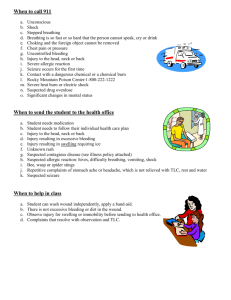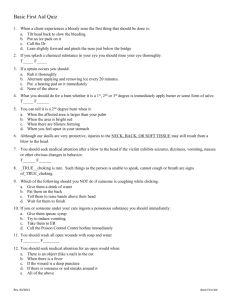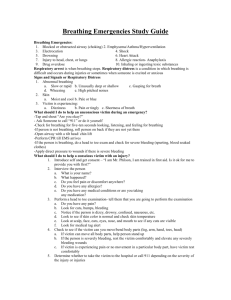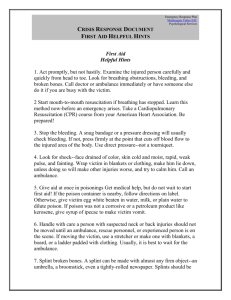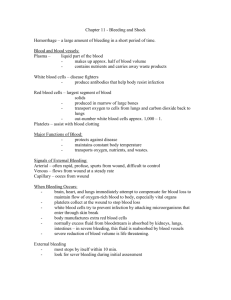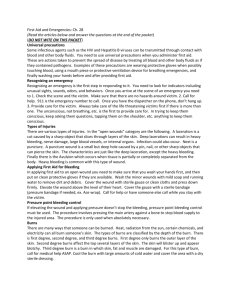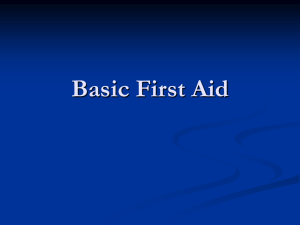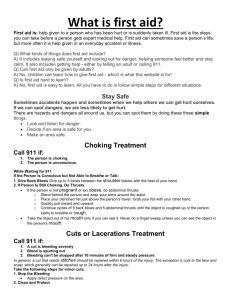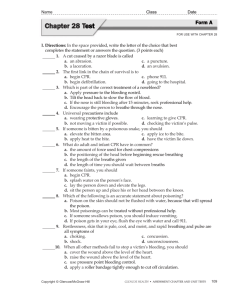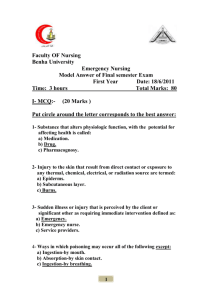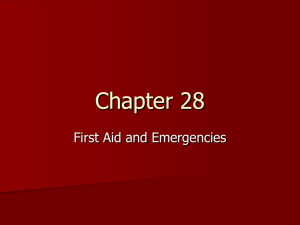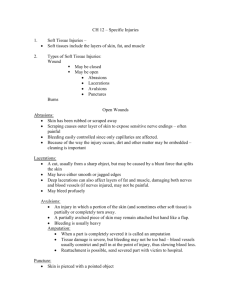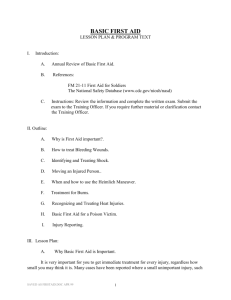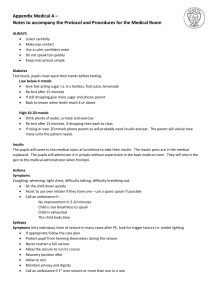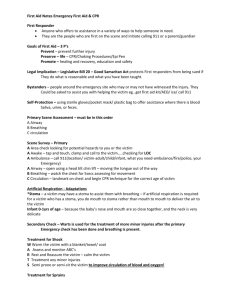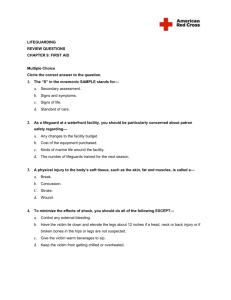Caring for Shock
advertisement
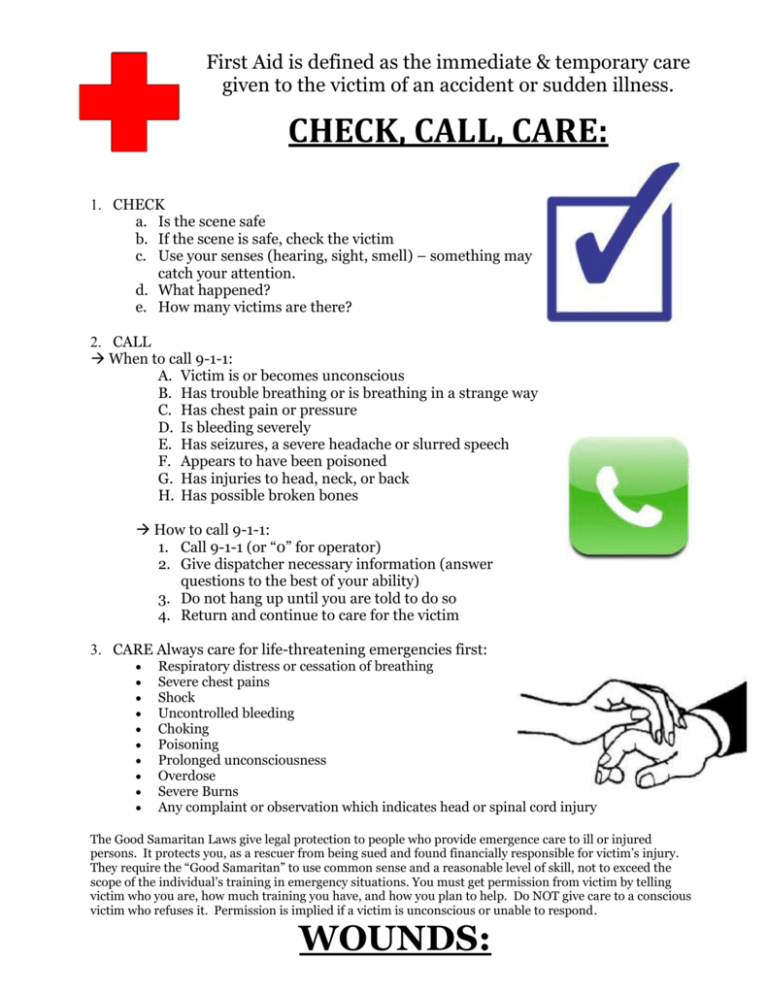
First Aid is defined as the immediate & temporary care given to the victim of an accident or sudden illness. CHECK, CALL, CARE: 1. CHECK a. Is the scene safe b. If the scene is safe, check the victim c. Use your senses (hearing, sight, smell) – something may catch your attention. d. What happened? e. How many victims are there? 2. CALL When to call 9-1-1: A. Victim is or becomes unconscious B. Has trouble breathing or is breathing in a strange way C. Has chest pain or pressure D. Is bleeding severely E. Has seizures, a severe headache or slurred speech F. Appears to have been poisoned G. Has injuries to head, neck, or back H. Has possible broken bones How to call 9-1-1: 1. Call 9-1-1 (or “0” for operator) 2. Give dispatcher necessary information (answer questions to the best of your ability) 3. Do not hang up until you are told to do so 4. Return and continue to care for the victim 3. CARE Always care for life-threatening emergencies first: Respiratory distress or cessation of breathing Severe chest pains Shock Uncontrolled bleeding Choking Poisoning Prolonged unconsciousness Overdose Severe Burns Any complaint or observation which indicates head or spinal cord injury The Good Samaritan Laws give legal protection to people who provide emergence care to ill or injured persons. It protects you, as a rescuer from being sued and found financially responsible for victim’s injury. They require the “Good Samaritan” to use common sense and a reasonable level of skill, not to exceed the scope of the individual’s training in emergency situations. You must get permission from victim by telling victim who you are, how much training you have, and how you plan to help. Do NOT give care to a conscious victim who refuses it. Permission is implied if a victim is unconscious or unable to respond. WOUNDS: WOUND: an injury to the soft tissue. SOFT TISSUE: Soft tissue refers to the layers of skin, fat, & muscle beneath the skin. Any time it is torn or damaged, the body is threatened. Severe bleeding can occur at skin’s surface or under it, where it’s harder to detect. Germs can get into the body through a scrape, cut, or puncture & cause an infection. Open Wound: A break in the skin (blood leaves the body). Closed Wound: Causes bleeding under the skin (bruise or internal bleeding). Types of Wounds: 1. ABRASION: outer layer of skin is damaged (scrape) Most common type of wound Caused by skin that’s been rubbed or scraped away Exposes nerve endings Painful! 2. AVULSION: often damages deeper tissues; bleeding is significant Skin may hang like a flap Example: Dog bites your ear off 3. INCISION: clean cut with a sharp object (knife) Also known as a laceration Jagged or smooth edges Knives, scissors, or broken glass Blow from a blunt object splits skin 4. PUNCTURE: object pierces layers of skin Bleeding can be severe if major blood vessel or internal organs are penetrated by object that remains embedded in (stuck in) the wound Example:Gun-shot wound could be an example BURNS: Definition- an injury to the soft tissue caused by exposure to heat or flame. 3 Levels of Burn: 1. Superficial (1st degree) a. Top layer of skin b. Skin red and dry with possible swelling c. Heals within a week without scarring 2. Partial Thickness (2nd degree) a. Top layers of skin b. Skin red and painful with blisters/clear fluid and swelling c. Heals within 3-4 weeks and may scar 3. Full Thickness (3rd degree) a. May destroy all layers of skin and possible structures underneath b. Skin has a charred look and can be extremely painful or not (if nerve endings are destroyed) c. Medical assistance to heal and scarring is likely Critical Burns: Potentially life threatening, disfiguring, and disabling Require medical attention Difficult to tell when a burn is critical Can’t tell how severe a burn is by the pain the person is feeling because the nerve endings may be destroyed CALL 911 IF: 1. 2. 3. 4. 5. 6. Person has trouble breathing Had burns covering more than one body part or a large surface area Has suspected burns to the airways (burns to mouth/nose) Head, neck, hands, feet, or genitals are burned Full thickness burn and is under 5 or older than 60 Burn is from chemical exposure, explosions, or electricity Caring for a Burn Victim: 1. 2. 3. 4. Remove from source of burning Cool burn with large amount of cold running water (Superficial burns only) Cover burn loosely with a sterile dressing DO NOT Remove clothing stuck to burnt area or use burn ointment/clean on severe burns POISONINGS: “About 92% of all poisonings take place in the home” A poison is a substance that causes injury, illness or death if it enters the body. A person can be poisoned by swallowing poison (foods, pills, medications, cleaning products, plants), breathing it (gases, fumes), absorbing it through the skin (poison ivy, oak, pesticides) and by having it injected into the body (insects bites, drugs) CHECKING the Scene: - Unusual odors? Flames/smoke? Open or spilled containers? Open medicine cabinet? Overturned plant? If you suspect a poison has been taken, try out the type of poison, quantity taken, when it taken, how much the person weighs. This information will help out when care is to be Signals of poisoning: - Nausea and vomiting Diarrhea Chest of abdominal pain Trouble Breathing Sweating Changes in consciousness Seizures Headache Dizziness Weakness Irregular pupil size Abnormal skin color and find was given. General Care: Remove person from the scene if it is dangerous Check levels of consciousness Care for life-threatening conditions If conscious ask questions (such as those listed) Call Nation Poison Control (800-222-1222) or 911 and follow their directions Insect Bite: Can be very painful but remember they are rarely fatal. Some however, have severe allergic reactions Remove stinger by scraping it away with a credit card of finger nail (DO NOT use tweezers) Was site with soap and water and cover the site to keep it clean Apply an ice pack to keep the swelling minimal Watch for signs of an allergic reaction SPRAINS VS. STRAINS: Sprain: Tearing of a ligament at a joint Strain: Stretching and tearing of muscles or tendons Hard to tell how bad an injury is to a muscle bone or joint therefore a CAT scan may be needed. Comparing a hurt ankle to the other ankle is a good way to see how injured it may be. Signals of serious muscle, bone, or joint injuries: - Significant deformity - Bruising and swelling - Inability to use the affected part normally - Person heard a pop or snap at time of injury - Injured area is cold and numb Caring for a muscle, bone or joint injuries- RICE: - Rest: Rest is vital to protect the injured muscle, tendon, ligament or other tissue from further injury. Resting the injured part is important to promote effective healing. - Ice: When icing an injury, choose a cold pack, crushed ice or a bag of frozen peas wrapped in a thin towel to provide cold to the injured area. - Compression: Compression helps limit and reduce swelling, which may delay healing. Some people also experience pain relief from compression. An easy way to compress the area of the injury is to wrap an ACE bandage around the swollen part. If you feel throbbing, or if the wrap just feels too tight, remove the bandage and re-wrap the area so the bandage is a little looser. - Elevation: Elevating an injury help control swelling. It's most effective when the injured area is raised above the level of the heart. For example, if you injure an ankle, try lying on your bed with your foot propped on one or two pillows. SPRAINS: Mild- Swell a bit, and heal quickly. Might not feel much pain and may become active too soon. If this happens, joint will not heal properly and will remain week and a more severe injury may occur Severe sprain can also involve a fracture or dislocation of the bones at the joint. Most injured joints: ankle, knee, wrist and fingers STRAINS: Often causes by lifting something heavy or working a muscle too hard. Some strains are reoccurring Most injured: neck, back, thigh, and back of lower leg BLEEDING: The amount of bleeding depends on the location and severity of the injury Severe bleeding can lead to shock Sometimes it is difficult to determine when someone is severely bleeding. Blood on a slick surface or mixed with water makes it appear there is more blood than there actually is Caring for External Bleeding: 1. Direct pressure- Use sterile bandages and wear gloves 2. Elevate (above the heart) 3. Indirect pressure (on pressure points) 4. If Bleeding does not stop call 911 INTERNAL BLEEDING SIGNALS: Tender swollen, bruised or hard areas of the body such as the abdomen Rapid, weak pulse Skin that feels cool or moist or looks pale or bluish Vomiting blood or coughing up blood Excessive thirst Becoming confused, faint, drowsy or unconscious Internal bleeding damages the body both from the loss of blood and from the pressure the misplaced blood puts on other organs and tissues. Treatment usually takes place in a hospital's emergency department. SHOCK: Depressed state of many body functions due to poor circulation Decrease in breathing & circulation Organs start to suffer/not function More likely to die from shock than from any other injury The greater damage to flesh, bones, & blood loss, the greater the shock Treat ALL serious injuries for SHOCK! Signs of Shock: Weakness (possible fainting) Nausea, vomiting Pale, cool, clammy skin Weak or rapid pulse Caring for Shock: 1. Call 911 2. Have victim lay down on back 3. Elevate legs about 12 inches unless you suspect head, neck, or back injuries or possible broken bones (if unsure of victims conditions, leave him/her lying flat) 4. Help maintain normal body temperature 5. Do not give victim food/drink 6. Calm victim 7. Monitor breathing, airway, circulation
